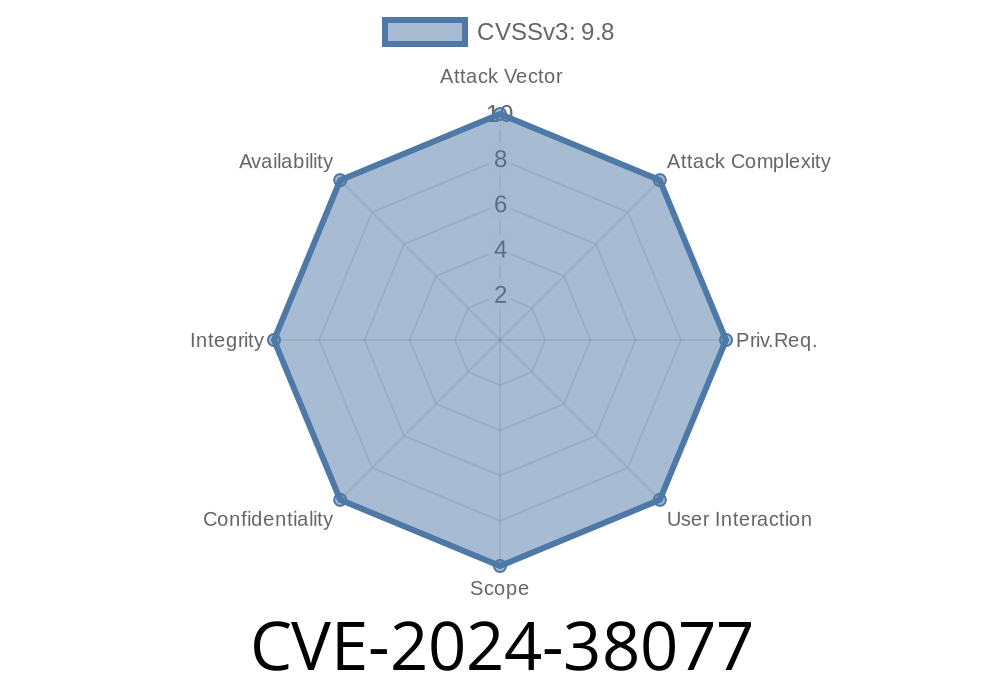*Published: 2024-07-15*
*Category: Security, Windows, RCE, CVE Analysis*
🔥 What is CVE-2024-38077 All About?
CVE-2024-38077’s discovery shook the cybersecurity scene in July 2024. This critical vulnerability affects Windows Remote Desktop Licensing Service (RD Licensing), providing attackers the ability to remotely execute code on vulnerable systems—potentially with SYSTEM privileges. That means one bad request can totally compromise servers used to license Remote Desktop connections across organizations.
This post breaks down how CVE-2024-38077 works, who’s at risk, the nitty-gritty technical details, and even shares a proof-of-concept (POC) snippet to help you understand and test the issue (in a safe lab), along with links to official advisories.
⚡ TL;DR
- Affected: Windows servers running Remote Desktop Licensing Service (RDS/Terminal Services Licensing).
🕵️♂️ Quick Background: What is The RD Licensing Service?
Remote Desktop Licensing is a Windows Server role that manages licenses required for RDS sessions. It typically listens for connections on TCP port 3389 (RDP), and for license issuance at port TCP 135 (RPC endpoint) and other dynamic RPC ports.
Since it is a critical backend service for RDP environments, exploitation can lead to total takeover of large corporate RDP infrastructures.
💣 Exploitation: How Does CVE-2024-38077 Work?
Let’s cut to the chase. The vulnerability is rooted in how the Licensing Service handles special RPC requests—specifically improper input validation within the LserverRequest method (a routine handling requests from RDP clients to activate or verify licenses).
A specially crafted message, sent unauthenticated, can trigger a buffer overflow or memory corruption, leading to arbitrary code execution as SYSTEM.
> Microsoft severity rating: 9.8 (Critical)
>
> _"An attacker who successfully exploited this vulnerability could gain SYSTEM privileges on the target server remotely."_
> — Microsoft Security Update Guide
Attack Surface
- Listening Ports: The Licensing Service exposes RPC endpoints, typically on TCP/135 and dynamic RPC ports to the network.
- Attack Path: Attacker sends a malformed RPC request to the Licensing Service, exploiting a bug in how the service parses licence validation requests.
Sample Offending Code (Hypothetical)
Here's a simplified example of what the vulnerable code could look like (the actual source is closed!):
// DO NOT use in real apps – this is for illustration!
NTSTATUS LserverRequest(LPCVOID rpcRequest, size_t reqSize) {
char buffer[512];
// BAD: copies user-controlled data without proper bounds check!
memcpy(buffer, rpcRequest, reqSize);
// ... further processing
}
If reqSize is larger than 512 bytes, attacker-controlled data spills over the buffer, corrupting memory—allowing injected shellcode or other exploits.
🧑💻 Proof of Concept (POC) Snippet
The following Python code outlines how an attacker may scan for vulnerable hosts by sending crafted RPC packets. Only use against your own test lab boxes! (This does NOT exploit, but shows the attack surface.)
import socket
def check_vuln(target_ip, port=135):
# Just a simple connect to Licensing Service port (RPC Endpoint)
try:
s = socket.socket()
s.settimeout(2)
s.connect((target_ip, port))
print(f"[*] {target_ip}:{port} is OPEN")
# A real POC would send a binary-encoded RPC message here
s.close()
except Exception as e:
print(f"[!] {target_ip}:{port} is closed or filtered ({e})")
if __name__ == '__main__':
check_vuln('192.168.1.100')
A full exploit would need to craft a valid RPC connection and deliver a payload exploiting the parsing bug in the Licensing Service.
Install the July 2024 Windows Updates:
Restrict Network Access
- Block external (Internet) access to TCP/135 and all RDP-related services.
Audit & Harden
- Use the principle of least privilege; don’t let untrusted machines reach critical backend services.
📚 References & More Reading
- Microsoft Advisory: CVE-2024-38077: Windows Remote Desktop Licensing Service Remote Code Execution Vulnerability
- NIST National Vulnerability Database Entry
- Rapid7 Analysis & Exposure Report
- Background on RDS Licensing Service
👀 Final Thoughts
CVE-2024-38077 is a big deal for anyone running Windows servers with RDS Licensing. Without patching, attackers can gain full control over key infrastructure—remotely and without any user even logging in.
Don’t panic!
Just patch fast, restrict access, and monitor your systems.
For more details, lab notes, and updates on this and other vulnerabilities, come back often—security never sleeps!
Timeline
Published on: 07/09/2024 17:15:42 UTC
Last modified on: 07/31/2024 23:00:05 UTC
